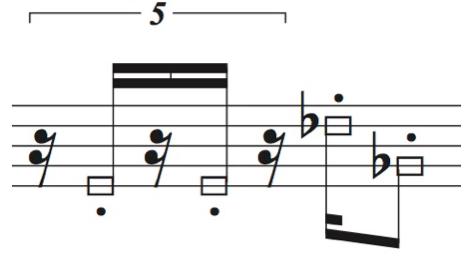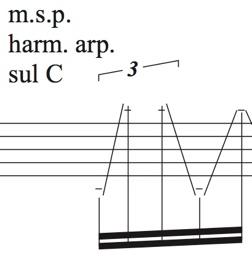LEWIS
Memex for Symphonic Orchestra
Full Score


Memex for Symphonic Orchestra
Full Score

for Symphonic Orchestra (2014)
Written for the BBC Scottish Symphony Orchestra
Full Score
POD PETERS on demand
Instrumentation
3 Flutes in C, 2nd and 3rd doubling Piccolo
3 Oboes
3 Clarinets in B-flat, 3rd doubling Bass Clarinet in B-flat
3 Bassoons, 3rd doubling Contrabassoon
4 Horns in F
3 Trumpets in C (mutes: straight, harmon with stem, plunger)
2 Tenor Trombones (mutes: straight, harmon with stem, plunger)
Bass Trombone (mutes: straight, harmon with stem, plunger)
Tuba in B-Flat
Piano (with ceramic cup or guitar slide)
Harp
3 Percussion (3 performers)
Percussion I
Snare drum
High tom-tom Bass drum
Small Triangle Bell cymbal
Small Tam-tam Castanets
Vibraphone
Percussion II
Timpani 32”, D2 to A2
Sizzle cymbal
Crotales (2 octaves)
Flexatone (with bow) 3 bossed gongs (D#5, E5, A5)
Medium tom-tom
Medium Tam-tam
China cymbal Crash ride cymbal (large, notated as “Lg. Cymb”)
Medium Triangle Castanets
Xylophone
Glockenspiel 3 bossed gongs (C#5, D#5, F#5)
Percussion III
Snare drum
Low tom-tom Bass drum
Splash cymbal Ride cymbal (large, notated as “Lg. Cymb”)
Large Tam-tam Large Triangle Castanets
Crotales (2 octaves) Vibraphone
3 bossed gongs (F5, G5, B5)
General: sticks, mallets, bows, brushes, Superball beaters
Flexatone (with bow)

Violins I
Violins II
Violas
Cellos
Contrabasses
Symbols
s.t.: sul tasto (arco)
s.p.: sul ponticello (arco), normal pressure
c.l.b.: col legno battuto
m.p.: moderate bow pressure
a.s.t.: alto sul tasto (arco)
a.s.p: alto sul ponticello (arco)
m.v.: molto vibrato
h.p.: heavy bow pressure
bisb.: bisbigliando (in winds, timbre trill) flz.: flutter-tongue
+ = closed plunger or harmon mute
o = open plunger or harmon mute
open noteheads (square/diamond): indicates air sound, growls, or other production of indefinite pitch

Clusters: Indefinite pitches in indicated register

harm. arp.: Harmonic arpeggio. Movement trajectories of the left hand are suggested by the indeterminate notation.

Performance Notes
The score is transposed, in the customary way:
Piccolo sounds an octave higher than written
Clarinet sounds a major 2nd lower than written Bass Clarinet part sounds a major 9th lower than written Contrabassoon sounds an octave lower than written Crotales sound two octaves higher than written Glockenspiel sounds two octaves higher than written Xylophone sounds one octave higher than written Contrabass sounds an octave lower than written
Specifications as to instruments, bowings, mutes, articulations, etc., are maintained until superseded by a subsequent specification, or by the “ord.” instruction. Accidentals carry through the measure. Trills are always half-step.
The three percussion setups (I, II, III) should be separated in space: Percussion I (stage left), Percussion II (stage middle), Percussion III (stage right).
voice grunt (winds): Use rough-textured voice and play at the same time.
flap tongue, slap tongue (winds): Both produce percussive sounds with some pitch content, which may be indeterminate in performance with respect to the written pitches. In brass, the technique is analogous to the flutist’s tongue ram.
air sound (woodwinds): Sharp, hissy breath textures are intended.
air sound, mouthpiece reversed (brass): Remove the mouthpiece and apply explosive tonguing to the shank end, with the cup of the mouthpiece near to, but not directly coupled to, the leadpipe of the instrument. Produces sharply percussive, wide-band noise attacks.
ceramic cup or guitar slide on strings (piano): A method of producing piano glissandi.
harm. arp. (strings): Harmonic arpeggio. Movement trajectories of the left hand are suggested by the indeterminate notation.
glissandi (all): short. leading toward an attack: Treated like grace notes. short, leading from a note: Analogous to a short verbal shout. long, trailing a note: Should not exceed the total duration of the note.
irregular speed (all): Used with trills and vibrato to produce non-uniform textures.
Duration: 17 minutes
Special gratitude and the utmost appreciation to Maestro Ilan Volkov and the members of the BBC Scottish Symphony Orchestra for their unstinting support of this project.